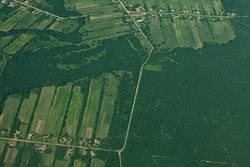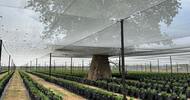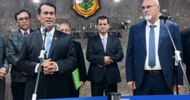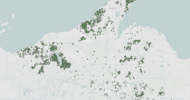Illegal Deforestation Monitor | September 2016
Ill-gotten lands: Deforestation and isolation in Paraguay’s Gran Chaco
When the government of Paraguay enacted a law banning deforestation in 2004, it marked what might have become one of the most significant success stories in global forest conservation. The Atlantic forest, that once stretched unbroken from the river Paraguay to the Brazilian coast, faced outright destruction at the hands of soy companies and cattle ranchers. As a result of the zero deforestation law, the rate of forest loss dropped precipitously; by 65% within two years, and by almost 95% within five. Though much of the forest had already been destroyed, this rearguard action represented a rare moment of decisive, state-led leadership in the global effort to stem deforestation.
Instead, the law played a significant role in what has become one of the world’s most pressing environmental crises. While affording legal protection to the tropical forests in eastern Paraguay’s east, the law did not extend to the altogether different forests in its west, in the land known as the Gran Chaco. As the rate of deforestation plummeted in the east, the Chaco experienced a commensurate wave of destruction. The contrast in fortunes was stark. Before the law was enacted the rate of deforestation in the Atlantic forest was the second highest in the world; a few years later, the Chaco was being destroyed faster than anywhere else on earth (WWF 2006; Hansen et al 2013).
While the deforestation was sanctioned, even encouraged, by the state and not in violation of the deforestation law, the expansion of agriculture into the Chaco has been carried out illegally in a range of other ways. It is founded upon the corrupt allocation of land during Paraguay’s 35-year dictatorship, it is violating the constitutional rights of its indigenous people and international law, and it is characterized by impunity and government complicity that allows violations of environmental law to go unpunished. Today the Gran Chaco is not only ground zero for deforestation; it is also ground zero for illegal, large-scale agriculture.
The Chaco and the Ayoreo
Paraguay is split down the middle by the river of the same name. The Rio Paraguay courses past the capital, Asuncion, which lies that the heart of the central belt that provided Paraguay with almost all of its agricultural land until the latter half of the 20th century. By the middle of the century, around half of the country was still covered in forests, which varied greatly depending on the direction taken from the river. To the east lay flat grasslands, swamps, and the dense tropical and subtropical forests that stretched for more than 1,000km to the Atlantic coast. To the west, the vast plains of the Gran Chaco, that continue north, west and south for hundreds of miles, into Bolivia and Argentina.
The plains have been built up over thousands of years by fine debris from the Andes mountains, distributed by meandering streams that traverse the Chaco and flow eventually into the Rio Paraguay. The flat, arid landscape gave rise to a unique biodiversity that differs starkly from that of the east; scrub woodlands, forests of thorny, deciduous trees, patches of tall savanna grass. Lucas Bessire, an American anthropologist who spent several years in the Chaco recalled “thicket so dense you can’t see more than ten or fifteen feet, even when you’re crawling through it.” (Bessire 2014) A report of a geological survey in the 1930s described “peculiar brush forests of mesquite and many other thorny semidesert plants that are adapted to alternations of severe droughts and prolonged wet seasons when almost all of the surface of the Gran Chaco is swampy or actually covered by water.” (US Department of the Interior 1959)
This forbidding landscape, amounting to the largest expanse of forest in South America outside the Amazon, offered no obvious resources of interest to colonial invaders, whose settlements were limited to the fringes of the Chaco. Most of Paraguay’s indigenous groups were subject to wholesale slaughter during the Spanish conquest and colonisation. But those whose territory lay in the Chaco were relatively unscathed until the 19th century. Several thousand people who identified themselves collectively as the Ayoreo led nomadic lifestyles in the remote wilds of the Chaco, in what falls within modern Paraguay and Bolivia. The Ayoreo were loosely organised into more than 50 groups that moved within extensive territories. With a dynamic social and political structure, individuals left, joined and formed new groups seamlessly. Until the intervention of outsiders, the vast territory used by the peripatetic Ayoreo for hunting and gathering stretched across more than 300 square kilometres of the Chaco (UNAP and IA 2010).
After independence from Spain was secured in 1811, however, successive authoritarian regimes “adopted policies aimed at confiscating lands in the Chaco” (UN Special Rapporteur 2015). These efforts accelerated in the early 20th century, when the government promoted immigration to the Chaco from Europe by offering parcels of land in Ayoreo territory (ibid). This led to the establishment of colonies of Mennonite missionaries in the southern reaches of their lands. The Mennonites were followed, more aggressively, by Protestant missionaries who sought to convert the Ayoreo. They were “lured into leaving their lives in the forest and deported to live in large, permanent settlements established by missionaries” on the fringes of their Chaco (UNAP and IA 2010). Throughout the dictatorship that prevailed in Paraguay from 1954 to 1989 indigenous peoples became the victims of “grave and systematic violations of their rights, including attacks by civilians and the military” (UN Special Rapporteur 2015), while legal rights to the lands from which they had been evicted were granted to others.
By the early 1990s, most of the once autonomous, nomadic Ayoreo lived a poverty-stricken existence in missionary settlements, providing occasional day labour to Mennonites farming their territories. In his book Behold the Black Caiman, Bessire describes the conditions in which he found settled Ayoreo communities in the mid-2000s. He found “thousands of […] Ayoreo-speaking people struggling to survive in the stark mission stations and makeshift labour camps that lined dirt roads for miles north of the Mennonite colonies”.
He wrote: “On both sides of the Bolivia/Paraguay border, Ayoreo-speaking people were the poorest and most marginalized of any Indigenous people in a region where camps of dispossessed Natives lined the roads and Indians were still held in conditions described as slavery. They confronted a mosaic of violence: enslavement, massacres, murder, and rape were venerable traditions”.
With the fall of its dictatorship and advent of democracy in the early 1990s, Paraguay enacted a constitution that recognised the existence of indigenous peoples and the fact that their laws and societies pre-dated those of the modern state. In what was regarded as one of the most progressive ever legal instruments globally with regard to indigenous peoples, the 1992 constitution recognised indigenous peoples’ right to their identity, customary laws, political, social and economic norms and – critically – their land rights. It stated that indigenous peoples were entitled to shared ownership of land “which will be sufficient both in terms of size and quality for them to preserve and to develop their own lifestyles”. The law was a marked break with the treatment of indigenous peoples during the dictatorship, when even their languages were banned from education.
For the Ayoreo who had been moved from the Chaco, and who now lived lives of poverty and discrimination outside their forests, the constitution provided hope they could return, fully adopting the culture and livelihoods they had not abandoned, even generations later. But it was potentially far more significant for as many as 300 Ayoreo who remained in isolation from the outside world. Split into several groups moving throughout the Chaco, these Ayoreo had evaded the missionaries and the early advances of cattle ranchers, and remained the only uncontacted tribe in South America outside the Amazon. Others still were in a state of “initial” contact.
The isolated Ayoreo came into occasional, accidental contact with outsiders that invariably prompted them to flee. On occasion they returned to attack the invaders with spears and arrows, driven by a “historical consciousness” of past violence associated with missionaries and the military (Bessire 2014). Without the Ayoreo customary land being secured on their behalf, under state law, it seemed inevitable that the groups in voluntary isolation would be forced into contact, with likely devastating effects. But they faced a huge obstacle to wresting back the land. Though the state had recognised that it belonged to the Ayoreo, it did not hold the rights to it: almost all of the land had been privatised.
To read the post in full visit Illegal Deforestation Monitor.
Ill-gotten lands: Deforestation and isolation in Paraguay’s Gran Chaco
When the government of Paraguay enacted a law banning deforestation in 2004, it marked what might have become one of the most significant success stories in global forest conservation. The Atlantic forest, that once stretched unbroken from the river Paraguay to the Brazilian coast, faced outright destruction at the hands of soy companies and cattle ranchers. As a result of the zero deforestation law, the rate of forest loss dropped precipitously; by 65% within two years, and by almost 95% within five. Though much of the forest had already been destroyed, this rearguard action represented a rare moment of decisive, state-led leadership in the global effort to stem deforestation.
Instead, the law played a significant role in what has become one of the world’s most pressing environmental crises. While affording legal protection to the tropical forests in eastern Paraguay’s east, the law did not extend to the altogether different forests in its west, in the land known as the Gran Chaco. As the rate of deforestation plummeted in the east, the Chaco experienced a commensurate wave of destruction. The contrast in fortunes was stark. Before the law was enacted the rate of deforestation in the Atlantic forest was the second highest in the world; a few years later, the Chaco was being destroyed faster than anywhere else on earth (WWF 2006; Hansen et al 2013).
While the deforestation was sanctioned, even encouraged, by the state and not in violation of the deforestation law, the expansion of agriculture into the Chaco has been carried out illegally in a range of other ways. It is founded upon the corrupt allocation of land during Paraguay’s 35-year dictatorship, it is violating the constitutional rights of its indigenous people and international law, and it is characterized by impunity and government complicity that allows violations of environmental law to go unpunished. Today the Gran Chaco is not only ground zero for deforestation; it is also ground zero for illegal, large-scale agriculture.
The Chaco and the Ayoreo
Paraguay is split down the middle by the river of the same name. The Rio Paraguay courses past the capital, Asuncion, which lies that the heart of the central belt that provided Paraguay with almost all of its agricultural land until the latter half of the 20th century. By the middle of the century, around half of the country was still covered in forests, which varied greatly depending on the direction taken from the river. To the east lay flat grasslands, swamps, and the dense tropical and subtropical forests that stretched for more than 1,000km to the Atlantic coast. To the west, the vast plains of the Gran Chaco, that continue north, west and south for hundreds of miles, into Bolivia and Argentina.
The plains have been built up over thousands of years by fine debris from the Andes mountains, distributed by meandering streams that traverse the Chaco and flow eventually into the Rio Paraguay. The flat, arid landscape gave rise to a unique biodiversity that differs starkly from that of the east; scrub woodlands, forests of thorny, deciduous trees, patches of tall savanna grass. Lucas Bessire, an American anthropologist who spent several years in the Chaco recalled “thicket so dense you can’t see more than ten or fifteen feet, even when you’re crawling through it.” (Bessire 2014) A report of a geological survey in the 1930s described “peculiar brush forests of mesquite and many other thorny semidesert plants that are adapted to alternations of severe droughts and prolonged wet seasons when almost all of the surface of the Gran Chaco is swampy or actually covered by water.” (US Department of the Interior 1959)
This forbidding landscape, amounting to the largest expanse of forest in South America outside the Amazon, offered no obvious resources of interest to colonial invaders, whose settlements were limited to the fringes of the Chaco. Most of Paraguay’s indigenous groups were subject to wholesale slaughter during the Spanish conquest and colonisation. But those whose territory lay in the Chaco were relatively unscathed until the 19th century. Several thousand people who identified themselves collectively as the Ayoreo led nomadic lifestyles in the remote wilds of the Chaco, in what falls within modern Paraguay and Bolivia. The Ayoreo were loosely organised into more than 50 groups that moved within extensive territories. With a dynamic social and political structure, individuals left, joined and formed new groups seamlessly. Until the intervention of outsiders, the vast territory used by the peripatetic Ayoreo for hunting and gathering stretched across more than 300 square kilometres of the Chaco (UNAP and IA 2010).
After independence from Spain was secured in 1811, however, successive authoritarian regimes “adopted policies aimed at confiscating lands in the Chaco” (UN Special Rapporteur 2015). These efforts accelerated in the early 20th century, when the government promoted immigration to the Chaco from Europe by offering parcels of land in Ayoreo territory (ibid). This led to the establishment of colonies of Mennonite missionaries in the southern reaches of their lands. The Mennonites were followed, more aggressively, by Protestant missionaries who sought to convert the Ayoreo. They were “lured into leaving their lives in the forest and deported to live in large, permanent settlements established by missionaries” on the fringes of their Chaco (UNAP and IA 2010). Throughout the dictatorship that prevailed in Paraguay from 1954 to 1989 indigenous peoples became the victims of “grave and systematic violations of their rights, including attacks by civilians and the military” (UN Special Rapporteur 2015), while legal rights to the lands from which they had been evicted were granted to others.
By the early 1990s, most of the once autonomous, nomadic Ayoreo lived a poverty-stricken existence in missionary settlements, providing occasional day labour to Mennonites farming their territories. In his book Behold the Black Caiman, Bessire describes the conditions in which he found settled Ayoreo communities in the mid-2000s. He found “thousands of […] Ayoreo-speaking people struggling to survive in the stark mission stations and makeshift labour camps that lined dirt roads for miles north of the Mennonite colonies”.
He wrote: “On both sides of the Bolivia/Paraguay border, Ayoreo-speaking people were the poorest and most marginalized of any Indigenous people in a region where camps of dispossessed Natives lined the roads and Indians were still held in conditions described as slavery. They confronted a mosaic of violence: enslavement, massacres, murder, and rape were venerable traditions”.
With the fall of its dictatorship and advent of democracy in the early 1990s, Paraguay enacted a constitution that recognised the existence of indigenous peoples and the fact that their laws and societies pre-dated those of the modern state. In what was regarded as one of the most progressive ever legal instruments globally with regard to indigenous peoples, the 1992 constitution recognised indigenous peoples’ right to their identity, customary laws, political, social and economic norms and – critically – their land rights. It stated that indigenous peoples were entitled to shared ownership of land “which will be sufficient both in terms of size and quality for them to preserve and to develop their own lifestyles”. The law was a marked break with the treatment of indigenous peoples during the dictatorship, when even their languages were banned from education.
For the Ayoreo who had been moved from the Chaco, and who now lived lives of poverty and discrimination outside their forests, the constitution provided hope they could return, fully adopting the culture and livelihoods they had not abandoned, even generations later. But it was potentially far more significant for as many as 300 Ayoreo who remained in isolation from the outside world. Split into several groups moving throughout the Chaco, these Ayoreo had evaded the missionaries and the early advances of cattle ranchers, and remained the only uncontacted tribe in South America outside the Amazon. Others still were in a state of “initial” contact.
The isolated Ayoreo came into occasional, accidental contact with outsiders that invariably prompted them to flee. On occasion they returned to attack the invaders with spears and arrows, driven by a “historical consciousness” of past violence associated with missionaries and the military (Bessire 2014). Without the Ayoreo customary land being secured on their behalf, under state law, it seemed inevitable that the groups in voluntary isolation would be forced into contact, with likely devastating effects. But they faced a huge obstacle to wresting back the land. Though the state had recognised that it belonged to the Ayoreo, it did not hold the rights to it: almost all of the land had been privatised.
To read the post in full visit Illegal Deforestation Monitor.














